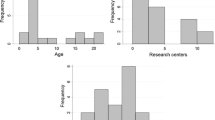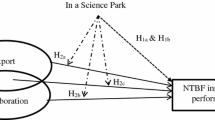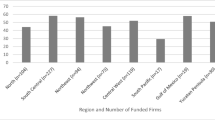Abstract
The main purpose of this paper is to analyse whether research spin-offs, that is, spin-offs from either public research institutes or universities, have greater innovation capabilities than comparable knowledge-intensive firms created in other ways. Using a sample of about 2,800 firms from highly innovative sectors, propensity score matching is used to create a sample group of control firms that is comparable to the group of spin-offs. The article provides evidence that the 121 research spin-offs investigated have more patent applications and more radical product innovations, on average, compared to similar firms. The results also show that research spin-offs’ superior innovation performance can be explained by their high level of research cooperation and by location factors. An urban region location and proximity to the parent institution are found to be conducive to innovation productivity. The article also finds evidence that research spin-offs are more successful in attracting support from public innovation support programmes in comparison to their peers.


Similar content being viewed by others
Notes
Examples of such programmes are TBU, FUTOUR and EXIST; see Egeln et al. (2002), Pleschak et al. (2002). Overall, 112 different innovation promotion programmes were covered in the survey and the results show that participation by the research spin-offs in the programmes is widespread. Note that only programme participation 2 years prior to the survey in 2004 is covered. Many innovation programmes focussed on stimulating network and cooperation activities of SMEs in East Germany, but some also gave a general subsidy to R&D wage costs (Belitz et al. 2001).
For the PSM method description, I closely follow Gantumur and Stephan (2012).
Note that this data set has also been used in a previous study, see Lejpras and Stephan (2011).
The survey questions are available from the author upon request.
The STATA procedure psmatch2, version 4.0.6 17, May 2012, was used. For details on this procedure, refer to Leuven and Sianesi (2003).
The results of the three probit models are shown in the "Appendix".
As one reviewer pointed out, Models I and II could have been omitted in the analysis because they are unnecessary if Model III turns out to be the correct model. On the other hand, Models I and II enable us to study the effects from including cooperation activities and location factors on the observed differences between treated (spin-offs) and their controls. For this reason, I report these benchmark results. However, when major results for university and research institute spin-offs are analysed later on, I omit Models I and II and directly present results from Model III.
Model I is based on 123 spin-offs, but due to missing values this drops to 121 observations for Model III.
It has been noted by one reviewer that the number of observations is rather low for this group. Therefore it is difficult to find robust effects, and the results should be interpreted with some caution.
References
Abadie, A., & Imbens, G. W. (2008). On the failure of the bootstrap for matching estimators. Econometrica, 76(6), 1537–1557. doi:10.3982/ECTA6474.
Andersson, M., & Klepper, S. (2013). Characteristics and performance of new firms and spinoffs in sweden. Industrial and Corporate Change 22(1), 245–280. http://ideas.repec.org/a/oup/indcch/v22y2013i1p245-280.html.
Audretsch, D. B., & Dohse, D. (2007). Location: A neglected determinant of firm growth. Review of World Economics, 143, 79–107. doi:10.1007/s10290-007-0099-7.
Audretsch, D. B., & Feldman, M. P. (1996). R&d spillovers and the geography of innovation and production. American Economic Review 86(3), 630–630. http://search.proquest.com/docview/233013124?accountid=11754.
Audretsch, D. B., & Feldman, M. P. (2004). Chapter 61 knowledge spillovers and the geography of innovation. In J. V. Henderson, J.-F. Thisse (Eds.), Cities and geography. Vol. 4 of handbook of regional and urban economics, (pp. 2713–2739). Amsterdam: Elsevier. http://www.sciencedirect.com/science/article/pii/S157400800480018X.
Audretsch, D. B., & Fritsch, M. (1994). On the measurement of entry rates. Empirica, 21, 105–113. doi:10.1007/BF01383974.
Audretsch, D. B., Lehmann, E. E., & Warning, S. (2005). University spillovers and new firm location. Research Policy 34(7), 1113–1122. http://www.sciencedirect.com/science/article/pii/S0048733305001071.
Audretsch, D. B., & Stephan, P. E. (1996). Company-scientist locational links: The case of biotechnology. American Economic Review 86(3), 641–641. http://search.proquest.com/docview/233024724?accountid=11754.
Baba, Y., Shichijo, N., & Sedita, S. R. (2009). How do collaborations with universities affect firms’ innovative performance? The role of Pasteur scientists in the advanced materials field. Research Policy 38(5), 756–764. http://www.sciencedirect.com/science/article/pii/S0048733309000067.
Beise, M., & Stahl, H. (1999). Public research and industrial innovations in germany. Research Policy 28(4), 397–422. http://www.sciencedirect.com/science/article/pii/S0048733398001267.
Belitz, H., Fleischer, F., & Stephan, A. (2001). Staatliche förderung von forschung und entwicklung in der ostdeutschen wirtschaft: Eine bilanz. DIW Wochenbericht 68(35), 537–544. http://ideas.repec.org/a/diw/diwwob/68-350-10.html.
Boeker, W. (1989). Strategic change: The effects of founding and history. The Academy of Management Journal, 32(3), 489–515.
Buenstorf, G., & Geissler, M. (2009). Not invented here: Technology licensing, knowledge transfer and innovation based on public research. Papers on Economics and Evolution 2009-20, Max Planck Institute of Economics, Evolutionary Economics Group. http://ideas.repec.org/p/esi/evopap/2009-20.html.
Caliendo, M., & Kopeinig, S. (2008). Some practical guidance for the implementation of propensity score matching. Journal of Economic Surveys, 22(1), 31–72. doi:10.1111/j.1467-6419.2007.00527.x.
Cameron, C. A., & Trivedi, P. K. (2005). Microeconometrics. Cambridge: Cambridge University Press.
Cantner, U., & Goethner, M. (2011). Performance differences between academic spin-offs and non-academic start-ups: A comparative analysis using a non-parametric matching approach.
Cantner, U., & Kösters, S. (2012). Picking the winner? Empirical evidence on the targeting of R&D subsidies to start-ups. Small Business Economics, 39(4), 921–936. doi:10.1007/s11187-011-9340-9.
Clarysse, B., Wright, M., & Van de Velde, E. (2011). Entrepreneurial origin, technological knowledge, and the growth of spin-off companies. Journal of Management Studies, 48(6), 1420–1442. doi:10.1111/j.1467-6486.2010.00991.x.
Cleyn, S. H. D., & Braet, J. (2009). The influence of government subsidies and risk capital on survival of university spin-offs: Findings from 16 early stage case studies. World Review of Entrepreneurship, Management and Sustainable Development, 5(4), 376–394.
Colombo, M. G., Dadda, D., & Piva, E. (2010). The contribution of university research to the growth of academic start-ups: An empirical analysis. Journal of Technology Transfer 35(1), 113–140. http://search.proquest.com/docview/203658381?accountid=11754.
Czarnitzki, D., Ebersberger, B., & Fier, A. (2007). The relationship between R&D collaboration, subsidies and R&D performance: Empirical evidence from finland and germany. Journal of Applied Econometrics, 22(7), 1347–1366. doi:10.1002/jae.992.
Czarnitzki, D., & Hottenrott, H. (2009). Are local milieus the key to innovation performance? Journal of Regional Science 49(1), 81–112. http://ideas.repec.org/a/bla/jregsc/v49y2009i1p81-112.html.
Czarnitzki, D., Rammer, C., & Toole, A. A. (2013). University spinoffs and the 'performance premium'. ZEW Discussion Papers 13-004, ZEW-Zentrum für Europäische Wirtschaftsforschung/Center for European Economic Research. http://ideas.repec.org/p/zbw/zewdip/13004.html.
Dehejia, R. H., & Wahba, S. (2002). Propensity score-matching methods for nonexperimental causal studies. Review of Economics and Statistics, 84(1), 151–161.
Egeln, J., Fryges, H., Gottschalk, S., & Rammer, C. (2009). Performance von akademischen spinoff-gründungen in österreich. AStA Wirtschafts- und Sozialstatistisches Archiv, 3(4), 265–283.
Egeln, J., Gottschalk, S., & Rammer, C. (2004). Location decisions of spin-offs from public research institutions. Industry and Innovation 11(3), 207–223. http://www.tandfonline.com/doi/abs/10.1080/1366271042000265384.
Egeln, J., Gottschalk, S., Rammer, C., & Spielkamp, A. (2002). Public research spin-offs in germany: Summary report. ZEW Dokumentationen 03-04, ZEW-Zentrum für Europäische Wirtschaftsforschung/Center for European Economic Research. http://ideas.repec.org/p/zbw/zewdok/0304.html.
Eickelpasch, A., & Pfeiffer, I. (2006). Unternehmen in ostdeutschland: Wirtschaftlicher erfolg mit innovationen. DIW Wochenbericht 73(14), 173–180. http://ideas.repec.org/a/diw/diwwob/73-14-1.html.
Gantumur, T., & Stephan, A. (2012). Mergers and acquisitions and innovation performance in the telecommunications equipment industry. Industrial and Corporate Change 21(2), 277–314. http://ideas.repec.org/a/oup/indcch/v21y2012i2p277-314.html.
Jensen, R., & Thursby, M. (2001). Proofs and prototypes for sale: The licensing of university inventions. The American Economic Review, 91(1), 240–259.
Keeble, D., Lawson, C., Smith, H. L., Moore, B., & Wilkinson, F. (1998). Collective learning processes and inter-firm networking in innovative high-technology regions. http://www.cbr.cam.ac.uk/pdf/WP086.pdf.
Klepper, S., & Sleeper, S. (2005). Entry by spinoffs. Management Science 51(8), 1291–1306. http://mansci.journal.informs.org/cgi/doi/10.1287/mnsc.1050.0411.
Koster, S. (2006). Whose child? How existing firms foster new firm formation: Individual start-ups, spin-outs and spin-offs. http://books.google.se/books?id=EPNdYgEACAAJ.
Krabel, S., & Mueller, P. (2009). What drives scientists to start their own company? An empirical investigation of max planck society scientists. Research Policy 38(6), 947–956. http://ideas.repec.org/a/eee/respol/v38y2009i6p947-956.html.
Lejpras, A., & Stephan, A. (2011). Locational conditions, cooperation, and innovativeness: Evidence from research and company spin-offs. The Annals of Regional Science, 46, 543–575. doi:10.1007/s00168-009-0356-x.
Leuven, E., & Sianesi, B. (2003). Psmatch2: Stata module to perform full mahalanobis and propensity score matching, common support graphing, and covariate imbalance testing. Statistical Software Components, Boston College Department of Economics. http://ideas.repec.org/c/boc/bocode/s432001.html.
Lockett, A., Siegel, D., Wright, M., & Ensley, M. D. (2005). The creation of spin-off firms at public research institutions: Managerial and policy implications. Research Policy 34(7), 981–993. http://www.sciencedirect.com/science/article/pii/S0048733305001113.
Longhi, C. (1999). Networks, collective learning and technology development in innovative high technology regions: The case of Sophia-Antipolis. Regional Studies 33(4), 333–342. http://www.tandfonline.com/doi/abs/10.1080/713693559.
Meyer, M. (2003). Academic entrepreneurs or entrepreneurial academics? Research-based ventures and public support mechanisms. R&D Management, 33(2), 107–115. doi:10.1111/1467-9310.00286.
Moray, N., & Clarysse, B. (2005). Institutional change and resource endowments to science-based entrepreneurial firms. Research Policy 34(7), 1010–1027. http://ideas.repec.org/a/eee/respol/v34y2005i7p1010-1027.html.
Mustar, P., Renault, M., Colombo, M. G., Piva, E., Fontes, M., Lockett, A., Wright, M., Clarysse, B., & Moray, N. (2006). Conceptualising the heterogeneity of research-based spin-offs: A multi-dimensional taxonomy. Research Policy 35(2), 289–308. http://www.sciencedirect.com/science/article/pii/S0048733305002192.
Pérez, M. P., & Sánchez, A. M. (2003). The development of university spin-offs: Early dynamics of technology transfer and networking. Technovation 23(10), 823–831. http://www.sciencedirect.com/science/article/pii/S0166497202000342.
Pirnay, F., Surlemont, B., & Nlemvo, F. (2003). Toward a typology of university spin-offs. Small Business Economics, 21(4), 355–369.
Pleschak, F., Berteit, H., Ossenkopf, B., & Stummer, F. (2002). Gründung und Wachstum FuE-intensiver Unternehmen. Untersuchungen in Ostdeutschland. Vol. 47 of Technik, Wirtschaft und Politik. Heidelberg: Physica.
Rosenbaum, P. R., & Rubin, D. B. (1984). Reducing bias in observational studies using subclassification on the propensity score. Journal of the American Statistical Association, 79(387), 516–524.
Rosenbaum, P. R., & Rubin, D. B. (1985). Constructing a control group using multivariate matched sampling methods that incorporate the propensity score. The American Statistician, 39(1), 33–38.
Rubin, D. B. (1997). Estimating causal effects from large data sets using propensity scores. Annals of Internal Medicine, 127(2), 757–763.
Åstebro, T., Braunerhjelm, P., & Broström, A. (2013). Does academic entrepreneurship pay? Industrial and Corporate Change 22(1), 281–311. http://icc.oxfordjournals.org/content/22/1/281.abstract.
Tenenhaus, M., Vinzi, V. E., Chatelin, Y.-M., & Lauro, C. (2005). Pls path modeling. Computational Statistics and Data Analysis 48(1), 159–205. http://www.sciencedirect.com/science/article/pii/S0167947304000519.
Walter, A., Auer, M., & Ritter, T. (2006). The impact of network capabilities and entrepreneurial orientation on university spin-off performance. Journal of Business Venturing 21(4), 541–567. http://www.sciencedirect.com/science/article/pii/S0883902605000261.
Wennberg, K., Wiklund, J., & Wright, M. (2011). The effectiveness of university knowledge spillovers: Performance differences between university spinoffs and corporate spinoffs. Research Policy 40(8), 1128–1143. http://www.sciencedirect.com/science/article/pii/S0048733311000953.
Wright, M., Lockett, A., Clarysse, B., & Binks, M. (2006). University spin-out companies and venture capital. Research Policy 35(4), 481–501. http://ideas.repec.org/a/eee/respol/v35y2006i4p481-501.html.
Zahra, S. A., Van de Velde, E., & Larraeta, B. (2007). Knowledge conversion capability and the performance of corporate and university spin-offs. Industrial and Corporate Change 16(4), 569–608. http://icc.oxfordjournals.org/content/16/4/569.abstract.
Zhang, J. (2009). The performance of university spin-offs: An exploratory analysis using venture capital data. The Journal of Technology Transfer, 34, 255–285. doi:10.1007/s10961-008-9088-9.
Zucker, L., Darby, M., & Brewer, M. (1998). Intellectual human capital and the birth of U.S. biotechnology enterprises. American Economic Review, American Economic Association, 88(1), 290–306.
Acknowledgments
I thank Anders Broström, Michael Fritsch, Karl Wennberg, and two anonymous reviewers for their helpful comments and suggestions. I’m also very grateful to the guest editor Helmut Fryges for his guidance through the revision process. The usual disclaimer applies.
Author information
Authors and Affiliations
Corresponding author
Rights and permissions
About this article
Cite this article
Stephan, A. Are public research spin-offs more innovative?. Small Bus Econ 43, 353–368 (2014). https://doi.org/10.1007/s11187-013-9539-z
Accepted:
Published:
Issue Date:
DOI: https://doi.org/10.1007/s11187-013-9539-z
Keywords
- Spin-offs
- Innovation performance
- Propensity score matching
- Location factors
- Cooperation
- Public R&D subsidies




